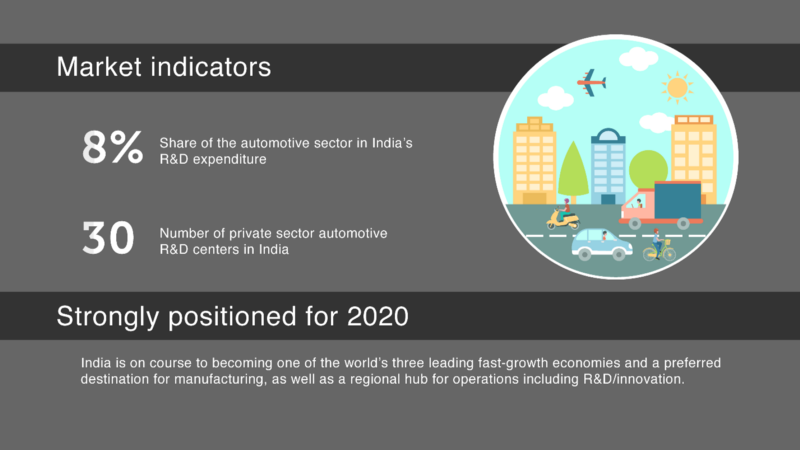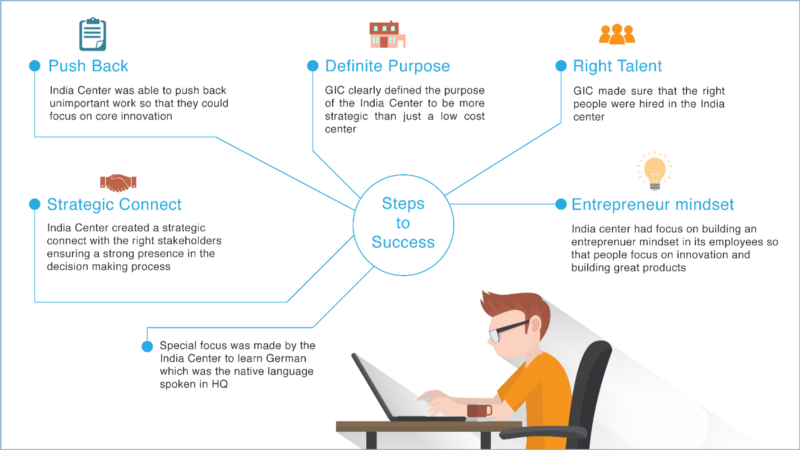|
|
The R&D and IT ecosystem in India is undergoing significant transformation. Global automotive manufacturers are looking to leverage the skilled talent pool present here to drive competitive advantage. There is rapid transformation in product design and development driven by changing customer needs and stringent regulations for safety and emissions. Cross R&D and innovation provide an ideal launch pad for new initiatives around connectivity, fuel efficiency, electric vehicles, and on-demand mobility.
India is steadily gaining importance as a strategic hub for both homegrown and global companies for their innovation initiatives in R&D and IT.
 India’s journey to becoming a preferred R&D hub
India’s journey to becoming a preferred R&D hub
In 1996, a global automobile major set up a captive centre in Bangalore to support in research, product development and IT operations. As with traditional GIC setups, this centre too was acting as a pure play cost centre for the parent company.
However, in 2007, the absence of clear expectations and constraints around the scope of GIC involvement led to the India center struggling with identity and culture issues. The global parent too started to question if the GIC had tangible potential and if it was driving any real value to the business. This ambiguity led to further problems such as cultural issues, lack of a sense of belonging to the brand, and an inability to leverage the existing talent for effective outcomes.
HQ soon realised that the business ecosystem was global, complex, and agile — which meant that they could no longer restrict the scope of their GICs to traditional definitions. The key initiative taken up by the company was to shift the charter of their GICs from simple cost saving centres to strategic hubs driving innovation and excellence.
The GIC headcount grew from a mere 10 in 1996 to a substantial 3000 in 2016. The global parent, aspiring to higher levels of capability maturity, soon started to hire talent with skills in emerging technologies.
The 2 main GICs in India operate of out Pune and Bangalore. The Bangalore unit focuses on areas like Computer Aided Design and Engineering (CAD and CAE), embedded systems and telematics as well as engineering IT tools. The Pune unit specializes in interior and exterior component design taking advantage of the proximity of local suppliers.
As of today, nearly 35–40 per cent of the company’s global R&D and IT team works out of Bengaluru, making it the second largest R&D centre in the world after Germany.
From struggling with issues of culture and identity, to becoming a centre of excellence, the GIC could enable this crucial transition due to the following initiatives:
 Strategic initiatives taken to improve efficiency of the GIC
Strategic initiatives taken to improve efficiency of the GIC
The GIC made an earnest attempt to change how its role was perceived and defined by the global parent. This attempt came with a significant set of risks — from the absence to the right talent required to drive this change to the possibility of their role becoming redundant in the overall value chain.
The risk paid off. The India center leveraged existing capabilities and designed clear strategic goals, ultimately resulting in a successful shift in perception. In 2012, the GIC filed 50 patents for innovations. This served as sufficient proof that the GIC had the capability to add significant value to the global parent’s main strategic focus areas.
In 2014, the automotive major inaugurated a second R&D center and an additional SAP Shared Services center in Bengaluru. Two years on, the GIC now has an advanced analytics center that generates crucial business insights for the Global Parent.
The Global Parent and the India GIC are focused on building capabilities that would ultimately help the GIC contribute to market expansion initiatives for the parent. The GIC’s 2020 roadmap is to integrate digitalization across the entire value chain — from design to manufacturing.
The center is already piloting small scale initiatives in this effort. The main philosophy is “Go digital or go home.” The GIC is now doing more than just CAD (computer-aided design) and CAE (computer-aided engineering). Once the design in CAD is ready, crash tests are done and load tests are computed digitally. Digital technology is further leveraged to measure stiffness and durability of components. This enables the product to have a longer digital shelf life, thereby providing valuable insights to future R&D initiatives.
There is no doubt that GICs drive significant value when used for the purpose they were initially set up for — as pure play cost centers. However, it is when global parents undertake bold plays to shift traditional roles, that the true value of the GIC can be leveraged.
The 2 main catalysts that can enable this shift is the right ecosystem and the presence of a skilled workforce. A structured and well thought out approach can enable global players to leverage GICs as more than just pure play cost centers. The main goal would be to enable the GIC to ultimately drive market expansion for the global parent at the region of operation.
Contributors: Manu Jain and Manu Srivastava contributed to the article.